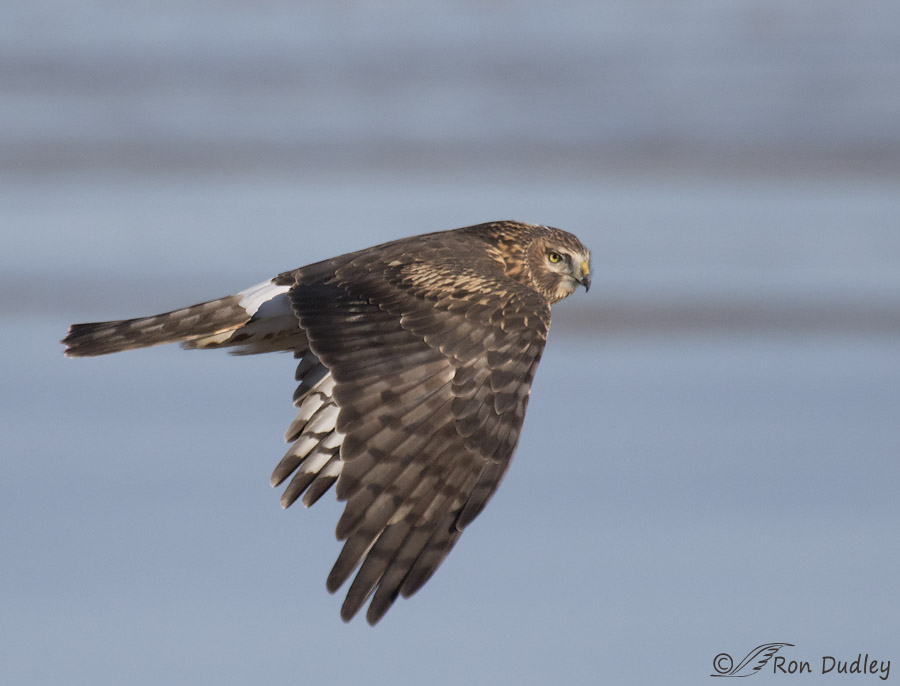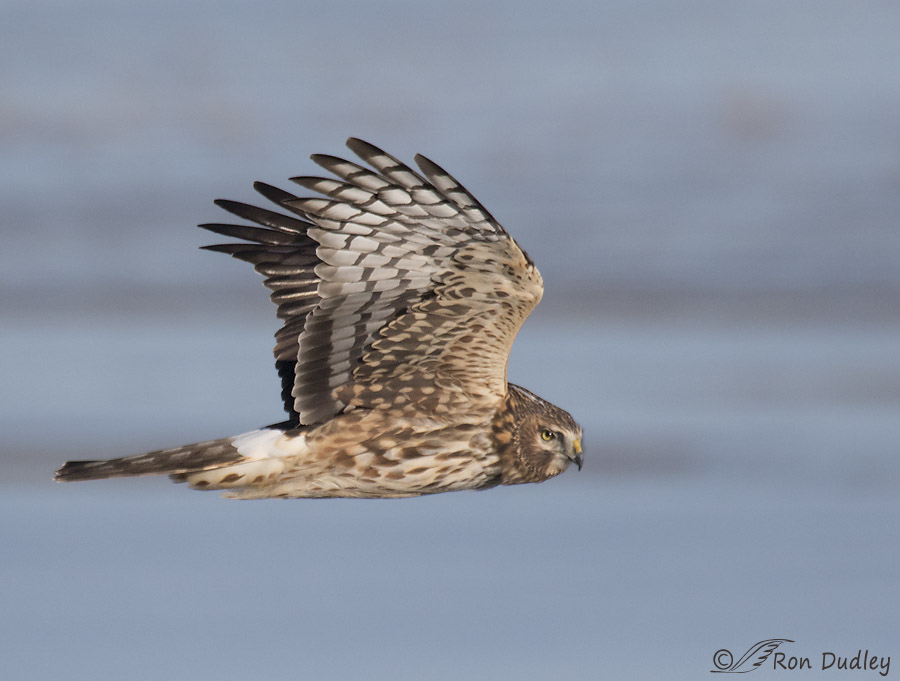These images combined the old and the new – my 8 year old 100-400mm zoom lens (with attached 1.4 teleconverter) and the new 7D Mark II camera. I thought the combination performed pretty well.

1/4000, f/8, ISO 1000, Canon 7D Mark II, Canon EF100-400mm f/4.5-5.6L IS USM @ 400mm +1.4 tc, not baited, set up or called in
I photographed this Northern Harrier a month ago as it was hunting the Antelope Island causeway. These two shots are consecutive images in a burst with the Great Salt Lake in the background, including horizontal bands of mud in the very shallow water. I found those mud bands useful in gauging something I’ve been mildly curious about – how much elevation is lost, if any, during the wing upbeat? (yes, I do wonder about trivial things like that…).
The two images were taken 1/10 second apart and the wings are in the down position in the first image and the up position in the second so the two images cover a single upbeat. The lowest band of mud behind the bird is an indicator of elevation since my elevation didn’t change. By comparing the position of the harrier relative to the mud band in the two photos…

1/4000, f/8, ISO 1000, Canon 7D Mark II, Canon EF100-400mm f/4.5-5.6L IS USM @ 400mm +1.4 tc, not baited, set up or called in
it appears that no net elevation was lost. Only the angle of attack changed, which tipped the head lower and the tail higher (first image to second image) but the center of gravity seemed to remain in the same position relative to the horizontal mud band. With most backgrounds this is something that would be difficult or impossible to judge.
But why do I care about stuff like this? That bit of knowledge likely has no practical application to bird photography so I guess it’s nothing more than “pure science” for me.
And curiosity.
Ron
Note: My shutter speed and ISO were excessive for the situation – another example of operator error.


I don’t mind the “operator errors”. Sure do look forward to seeing your photos each morning.
The Northern Harrier has become one of my favorite birds…your shots are just great. The scientific part is ok, but I’ve got a long way to go to understand things as you do…just keep up the good work!
I always thought the swoopy flight of bitds. Like chickadees and kingfishers was because of loss of altit ude beetween wing flaps, but now……
It often is in many smaller songbirds, Patty, because some of them fold their wings in flight between beats. Raptors don’t do that.
When I first saw “mud band” (on my iPad, I didn’t see the whole post to start), I thought, “Ah, a new term to remember for feather markings…always learning something new from Ron!” Well, I am learning something new, but mostly that I need to read the full text before committing something to the memory bank. Ha.
Anyway, these Harrier photos are breathtaking — and I appreciate your curiosity about (and explanation of) its potential loss of elevation as it flaps those big wings. Pure science…pure poetry!
At least you spotted your original misunderstanding in time, Chris. Sometimes I haven’t in the past so I’ve become a little paranoid about it. Thank you.
Curiosity is always good. May it never die in us! You wouldn’t be a biologist without it. And the photos are beautiful. We’ve been seeing a female Northern Harrier hanging around outside Hueco Tanks. She seems to usually be there to greet us as we drive in. That always makes for a happy day.
I feel the same way about harriers at Farmington, Susan. They usually do come out to greet (taunt…) me when I first drive in.
One of the main indicators of intelligence, is curiousity….I rest my case. That wonderful image looks as if the bird is saying, “Hey, Ron! Wuzzup!”
I’ll take that as a compliment, Patty. Thank you.
Great observation Ron. Who knows, it might be the next big breakthrough in aviation engineering!
Larry, As you know, the only thing I “discovered” was something that was new to me. For that reason I still found it interesting.
Wonderful shots Ron!
Charlotte
Thanks, Charlotte.
Great sequence. Don’t let anything diminish your curiosity or your interest in “pure science” because your blog wouldn’t be the same without it.
When I think of curiosity and scientific inquiry you’re the first person I know that comes to mind, Dave. Thank you.